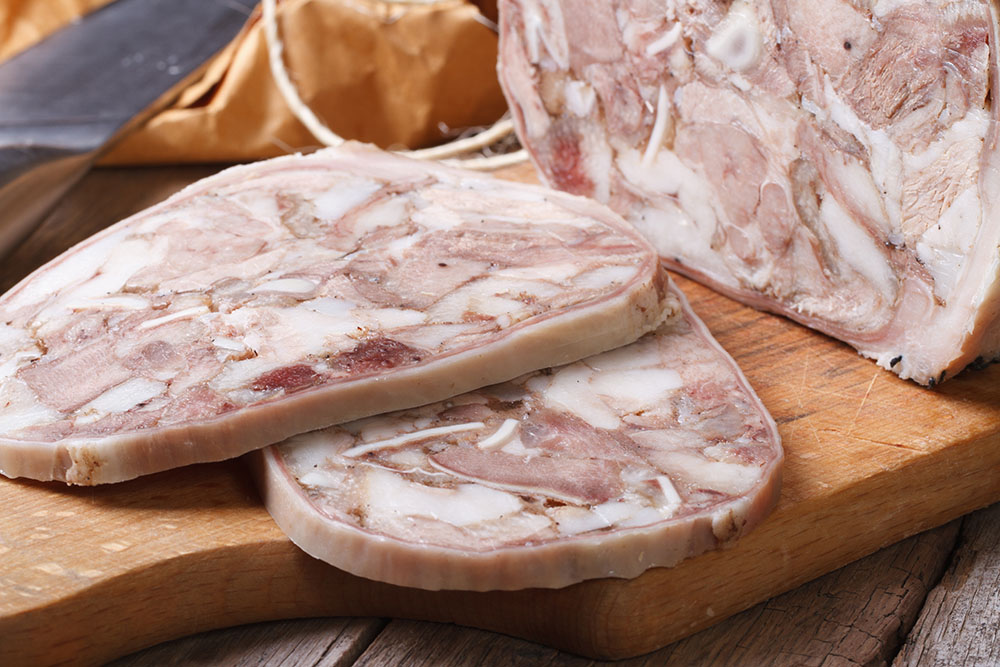Discover Head Cheese: A Unique Delicacy
Ever wonder what lies beneath the deceptively simple name "head cheese"? It's a culinary enigma, a testament to resourcefulness, and a flavor experience unlike any other. This seemingly humble dish boasts a rich history and surprising versatility, defying expectations and tempting palates for centuries.
Head cheese, despite its name, isn't cheese at all. Rather, it's a terrine, a mosaic of meaty morsels suspended in a shimmering, savory jelly. Its origins lie in the practical kitchens of our ancestors, a testament to their ingenuity in utilizing every part of the animal. From the peasant tables of medieval Europe to the charcuterie boards of modern gourmands, head cheese has carved a unique place in culinary history.
| Name | Head Cheese (also known as Fromage de Tte, Brawn, Coppa di Testa) |
|---|---|
| Origin | Europe (variations exist across Europe and North America) |
| Primary Ingredients | Pork head (including jowls, skin, tongue, snout, ears, heart), Calf head (sometimes including feet and heart), Pork broth, Spices, Gelatin (natural or added) |
| Preparation | Simmering the head and other parts until tender, then pressing and setting the meat in its natural gelatin or with added gelatin. Often flavored with spices like onion, garlic, cloves, nutmeg, and mace. |
| Serving Suggestions | Served cold, often sliced and enjoyed on bread, crackers, or as part of a charcuterie board. Can also be used as a spread or incorporated into other dishes. |
| Reference | Wikipedia - Head Cheese |
The very name, "head cheese," is a source of both confusion and intrigue. Its etymology traces back to a mistranslation of the French term "fromage de tte," literally "head cheese." While the French name evokes a certain rustic charm, the English translation often elicits a less enthusiastic response. Perhaps "brawn," the traditional English name, with its connotations of strength and substance, might have been a more fitting moniker. Nevertheless, the name "head cheese" has stuck, adding to the mystique of this often-misunderstood delicacy.
From a culinary perspective, head cheese is a study in textures and flavors. The various cuts of meat the tender jowls, the chewy ears, the rich tongue contribute a complex interplay of textures, while the flavorful broth, infused with spices and herbs, provides a unifying savory depth. The gelatinous consistency, whether derived naturally from the meat or added during preparation, binds these elements together, creating a unique and satisfying mouthfeel.
Creating head cheese is a labor of love, a process that demands patience and precision. It begins with the careful selection of a pig's head, ensuring the freshest and highest quality ingredients. The head, along with other chosen cuts like hocks or shanks, is simmered slowly in a richly flavored broth, infused with aromatic vegetables and spices. This long, slow cooking process extracts the collagen from the meat, transforming it into a luscious, gelatinous base.
Once the meat is tender, it is carefully removed from the broth, the bones are discarded, and the remaining meat is shredded or chopped. This mixture is then seasoned with a blend of spices, which can vary depending on regional traditions and personal preferences. Some recipes call for classic combinations of cloves, nutmeg, and mace, while others embrace more savory profiles featuring herbs like thyme and bay leaf.
The seasoned meat is then packed into a mold, and the flavorful broth is poured over it. As the mixture cools, the gelatin solidifies, transforming the loose collection of meat and broth into a firm, sliceable terrine. The result is a visually stunning dish, a mosaic of meaty morsels suspended in a glistening, savory jelly.
Enjoying head cheese is an experience in itself. Traditionally served cold, it can be sliced and enjoyed on bread, crackers, or as part of a charcuterie board. Its unique texture and rich flavor make it a perfect complement to sharp cheeses, tangy pickles, and crusty bread. Some variations incorporate vinegar or other acidic ingredients, lending a bright, piquant note to the savory profile.
Beyond its traditional applications, head cheese also finds its way into a variety of other culinary creations. It can be diced and added to salads, used as a filling for savory pastries, or incorporated into stews and other hearty dishes. Its versatility makes it a welcome addition to any adventurous cook's repertoire.
Head cheese, with its intriguing name, unique texture, and rich history, is a culinary adventure waiting to be explored. Whether enjoyed as a traditional cold cut or incorporated into more innovative dishes, it offers a flavor experience that is both surprising and satisfying. So, the next time you encounter this enigmatic dish, don't be afraid to take a bite and discover the delicious secrets hidden within.
From the rustic kitchens of our ancestors to the modern tables of today, head cheese remains a testament to the ingenuity and resourcefulness of cooks throughout history. It's a dish that defies easy categorization, a culinary chameleon that can be both humble and refined, traditional and innovative. And perhaps, that is the true essence of its enduring appeal.


